Decoding Peroxidase Gene Function in Heat Stress Adaptation of Tetranychus urticae: Unraveling Molecular Mechanisms of Short-Term Thermal Tolerance
Abstract
1. Introduction
2. Materials and Methods
2.1. Mite Colony
2.2. Selection of POD Genes
2.3. Cloning the CDSs of POD Genes
2.4. Identification and Phylogenetic Analysis of POD Proteins
2.5. Bioinformatic Analysis of POD Proteins
2.6. Short-Term Heat Stress Treatment of T. urticae
2.7. Analysis of POD Gene Expression
2.8. Statistical Analysis
3. Results
3.1. Selection of POD Genes
3.2. Verification of the Accuracy of Cloned POD Protein Sequences
3.3. Sequence and Phylogenetic Analysis of POD Proteins
3.4. Physicochemical Properties and Protein Structure of TuPODs
3.5. Differential Expression of TuPOD Genes Under Short-Term Heat Stress
4. Discussion
5. Conclusions
Supplementary Materials
Author Contributions
Funding
Institutional Review Board Statement
Informed Consent Statement
Data Availability Statement
Conflicts of Interest
References
- Bensoussan, N.; Santamaria, M.E.; Zhurov, V.; Diaz, I.; Grbić, M.; Grbić, V. Plant-herbivore interaction: Dissection of the cellular pattern of Tetranychus urticae feeding on the host plant. Front. Plant. Sci. 2016, 7, 1105. [Google Scholar] [CrossRef]
- Assouguem, A.; Kara, M.; Ramzi, A.; Annemer, S.; Kowalczyk, A.; Ali, E.A.; Moharram, B.A.; Lazraq, A.; Farah, A. Evaluation of the effect of four bioactive compounds in combination with chemical product against two spider mites Tetranychus urticae and Eutetranychus orientalis (Acari: Tetranychidae). Evid-Based Compl. Alt. 2022, 2022, 2004623. [Google Scholar] [CrossRef] [PubMed]
- Bocianowski, J.; Jakubowska, M.; Zawada, D.; Dobosz, R. The effect of acaricide control of the two-spotted spider mite Tetranychus urticae Koch on the cultivation of sugar beet (Beta vulgaris L.) and on the size and quality of the yield. Appl. Sci. 2022, 12, 12139. [Google Scholar] [CrossRef]
- Gotoh, T.; Moriya, D.; Nachman, G. Development and reproduction of five Tetranychus species (Acari: Tetranychidae): Do they all have the potential to become major pests? Exp. Appl. Acarol. 2015, 66, 453–479. [Google Scholar] [CrossRef] [PubMed]
- Thomas, T.; Gösta, N.; Bernhard, S.; Ida, S.; Andreas, W. Parental exposure to heat waves improves offspring reproductive investment in Tetranychus urticae (Acari: Tetranychidae), but not in its predator, Phytoseiulus persimilis (Acari: Phytoseiidae). Ecol. Evol. 2023, 13, e10748. [Google Scholar] [CrossRef]
- Filazzola, A.; Matter, S.F.; MacIvor, J.S. The direct and indirect effects of extreme climate events on insects. Sci. Total Environ. 2021, 769, 145161. [Google Scholar] [CrossRef]
- Stazione, L.; Norry, F.M.; Sambucetti, P. Heat-hardening effects on mating success at high temperature in Drosophila melanogaster. J. Therm. Biol. 2019, 80, 172–177. [Google Scholar] [CrossRef]
- Paaijmans, K.P.; Heinig, R.L.; Seliga, R.A.; Blanford, J.I.; Blanford, S.; Murdock, C.C.; Thomas, M.B. Temperature variation makes ectotherms more sensitive to climate change. Global Chang. Biol. 2013, 19, 2373–2380. [Google Scholar] [CrossRef]
- Xiao, L.; Huang, L.L.; He, H.M.; Xue, F.S.; Tang, J.J. Life history responses of the small brown planthopper Laodelphax striatellus to temperature change. J. Therm. Biol. 2023, 115, 103626. [Google Scholar] [CrossRef]
- Coombs, M.R.; Bale, J.S. Comparison of thermal activity thresholds of the spider mite predators Phytoseiulus macropilis and Phytoseiulus persimilis (Acari: Phytoseiidae). Exp. Appl. Acarol. 2013, 59, 435–445. [Google Scholar] [CrossRef]
- Stavrinides, M.C.; Daane, K.M.; Lampinen, B.D.; Mills, N.J. Plant water stress, leaf temperature, and spider mite (Acari: Tetranychidae) outbreaks in California vineyards. Environ. Entomol. 2010, 39, 1232–1241. [Google Scholar] [CrossRef] [PubMed]
- Stavrinides, M.C.; Lara, J.R.; Mills, N.J. Comparative influence of temperature on development and biological control of two common vineyard pests (Acari: Tetranychidae). Biol. Control 2010, 55, 126–131. [Google Scholar] [CrossRef]
- Stavrinides, M.C.; Mills, N.J. Influence of temperature on the reproductive and demographic parameters of two spider mite pests of vineyards and their natural predator. BioControl 2011, 56, 315–325. [Google Scholar] [CrossRef]
- Gotoh, T.; Yamaguchi, K.; Mori, K. Effect of temperature on life history of the predatory mite Amblyseius (Neoseiulus) californicus (Acari: Phytoseiidae). Exp. Appl. Acarol. 2004, 32, 15–30. [Google Scholar] [CrossRef] [PubMed]
- Kaur, M.; Chadha, P.; Kaur, S.; Kaur, A. Effect of Aspergillus flavus on lipid peroxidation and activity of antioxidant enzymes in midgut tissue of Spodoptera litura larvae. Arch. Phytopathol. Plant. 2020, 54, 177–190. [Google Scholar] [CrossRef]
- Dampc, J.; Kula-Maximenko, M.; Molon, M.; Durak, R. Enzymatic defense response of apple aphid Aphis pomi to increased temperature. Insects 2020, 11, 436. [Google Scholar] [CrossRef]
- Foyer, C.H.; Shigeoka, S. Understanding oxidative stress and antioxidant functions to enhance photosynthesis. Plant Physiol. 2011, 155, 93–100. [Google Scholar] [CrossRef]
- Hughes, A.L. Evolution of the heme peroxidases of Culicidae (Diptera). Psyche-J. Entomol. 2012, 2012, 146387. [Google Scholar] [CrossRef][Green Version]
- Liu, X.; Fu, Z.X.; Kang, Z.W.; Li, H.; Liu, T.X.; Wang, D. Identification and characterization of antioxidant enzyme genes in parasitoid Aphelinus asychis (Hymenoptera: Aphelinidae) and expression profiling analysis under temperature stress. Insects 2022, 13, 447. [Google Scholar] [CrossRef]
- Li, W.Z.; Zhu, T.; Zhou, J.J.; Shang, S.Q. Effects of short-term heat stress on the activity of three antioxidant enzymes of predatory mite Neoseiulus barkeri (acari, phytoseiidae). Front. Physiol. 2022, 13, 937033. [Google Scholar] [CrossRef]
- Lu, F.P.; Chen, Q.; Chen, Z.S.; Lu, H.; Xu, X.L.; Jing, F.L. Effects of heat stress on development, reproduction and activities of protective enzymes in Mononychellus mcgregori. Exp. Appl. Acarol. 2014, 63, 267–284. [Google Scholar] [CrossRef]
- Zhang, S.Z.; Fu, W.Y.; Li, N.; Zhang, F.; Liu, T.X. Antioxidant responses of Propylaea japonica (Coleoptera: Coccinellidae) exposed to high temperature stress. J. Insect Physiol. 2015, 73, 47–52. [Google Scholar] [CrossRef] [PubMed]
- Khurshid, A.; Inayat, R.; Tamkeen, A.; UIHaq, I.; Li, C.C.; Boamah, S.; Zhou, J.J.; Liu, C.Z. Antioxidant enzymes and heat-shock protein genes of green peach aphid (Myzus persicae) under short-time heat stress. Front. Physiol. 2021, 12, 805509. [Google Scholar] [CrossRef]
- Yuan, J.W.; Zheng, Y.T.; Chang, Y.W.; Bai, J.; Qin, J.; Du, Y.Z. Differential regulation of antioxidant enzymes in Frankliniella occidentalis (Thysanoptera: Thripidae) exposed to thermal stress. PeerJ 2021, 9, e12089. [Google Scholar] [CrossRef] [PubMed]
- Zhu, T.; Li, W.Z.; Xue, H.; Dong, S.B.; Wang, J.H.; Shang, S.Q.; Dewer, Y. Selection, identification, and transcript expression analysis of antioxidant enzyme genes in Neoseiulus barkeri after short-term heat stress. Antioxidants 2023, 12, 1998. [Google Scholar] [CrossRef]
- Nie, P.C.; Yang, R.L.; Zhou, J.J.; Dewer, Y.; Shang, S.Q. Elucidating the effect of temperature stress on the protein content, total antioxidant capacity, and antioxidant enzyme activities in Tetranychus urticae (Acari: Tetranychidae). Insects 2023, 14, 429. [Google Scholar] [CrossRef] [PubMed]
- Grbić, M.; Van Leeuwen, T.; Clark, R.M.; Rombauts, S.; Rouzé, P.; Grbić, V.; Osborne, E.J.; Dermauw, W.; Cao, T.N.P.; Ortego, F.; et al. The genome of Tetranychus urticae reveals herbivorous pest adaptations. Nature 2011, 479, 487–492. [Google Scholar] [CrossRef]
- Li, W.Z.; Kang, W.J.; Zhou, J.J.; Shang, S.Q.; Shi, S.L. The antennal transcriptome analysis and characterizations of odorant-binding proteins in Megachile saussurei (Hymenoptera, Megachilidae). BMC Genom. 2023, 24, 781. [Google Scholar] [CrossRef]
- Jumper, J.; Evans, R.; Pritzel, A.; Green, T.; Figurnov, M.; Ronneberger, O.; Tunyasuvunakool, K.; Bates, R.; Žídek, A.; Potapenko, A.; et al. Highly accurate protein structure prediction with AlphaFold. Nature 2021, 596, 583–589. [Google Scholar] [CrossRef]
- Wei, B.; Nie, P.C.; Liu, Y.; Hou, N.Y.; Shi, F.Y.; Shao, J.W.; Gao, Y.X.; Shang, S.Q.; Dewer, Y. Molecular identification and characterization of the superoxide dismutase (SOD) gene family in Tetranychus urticae (Acari: Tetranychidae) and the role of TuSOD2 gene under short-term heat stress. Int. J. Biol. Macromol. 2024, 283, 137233. [Google Scholar] [CrossRef]
- Livak, K.J.; Schmittgen, T.D. Analysis of relative gene expression data using real-time quantitative PCR and the 2-ΔΔCT method. Methods 2001, 25, 402–408. [Google Scholar] [CrossRef]
- Adesanya, A.W.; Lavine, M.D.; Moural, T.W.; Lavine, L.C.; Zhu, F.; Walsh, D.B. Mechanisms and management of acaricide resistance for Tetranychus urticae in agroecosystems. J. Pest Sci. 2021, 94, 639–663. [Google Scholar] [CrossRef]
- González-Tokman, D.; Córdoba-Aguilar, A.; Dáttilo, W.; Lira-Noriega, A.; Sánchez-Guillén, R.A.; Villalobos, F. Insect responses to heat: Physiological mechanisms, evolution and ecological implications in a warming world. Biol. Rev. 2020, 95, 802–821. [Google Scholar] [CrossRef] [PubMed]
- Fukuhara, R.; Kageyama, T. Structure, gene expression, and evolution of primate copper chaperone for superoxide dismutase. Gene 2013, 516, 69–75. [Google Scholar] [CrossRef]
- Umasuthan, N.; Bathige, S.D.N.K.; Revathy, K.S.; Lee, Y.; Whang, I.; Choi, C.Y.; Park, H.C.; Lee, J. A manganese superoxide dismutase (MnSOD) from Ruditapes philippinarum: Comparative structural- and expressional- analysis with copper/zinc superoxide dismutase (Cu/ZnSOD) and biochemical analysis of its antioxidant activities. Fish Shellfish Immun. 2012, 33, 753–765. [Google Scholar] [CrossRef] [PubMed]
- Xikeranmu, Z.; Abdunasir, M.; Ma, J.; Tusong, K.; Liu, X.N. Characterization of two copper/zinc superoxide dismutases (Cu/Zn-SODs) from the desert beetle Microdera punctipennis and their activities in protecting E. coli cells against cold. Cryobiology 2019, 87, 15–27. [Google Scholar] [CrossRef]
- Li, D.; Blasevich, F.; Theopold, U.; Schmidt, O. Possible function of two insect phospholipid-hydroperoxide glutathione peroxidases. J. Insect Physiol. 2003, 49, 1–9. [Google Scholar] [CrossRef]
- Kang, Z.W.; Liu, F.H.; Liu, X.; Yu, W.B.; Tan, X.L.; Zhang, S.Z.; Tian, H.G.; Liu, T.X. The potential coordination of the heat-shock proteins and antioxidant enzyme genes of Aphidius gifuensis in response to thermal stress. Front. Physiol. 2017, 8, 976. [Google Scholar] [CrossRef]
- An, M.I.; Choi, C.Y. Activity of antioxidant enzymes and physiological responses in ark shell, Scapharca broughtonii, exposed to thermal and osmotic stress: Effects on hemolymph and biochemical parameters. Comp. Biochem. Physiol. B 2010, 155, 34–42. [Google Scholar] [CrossRef]
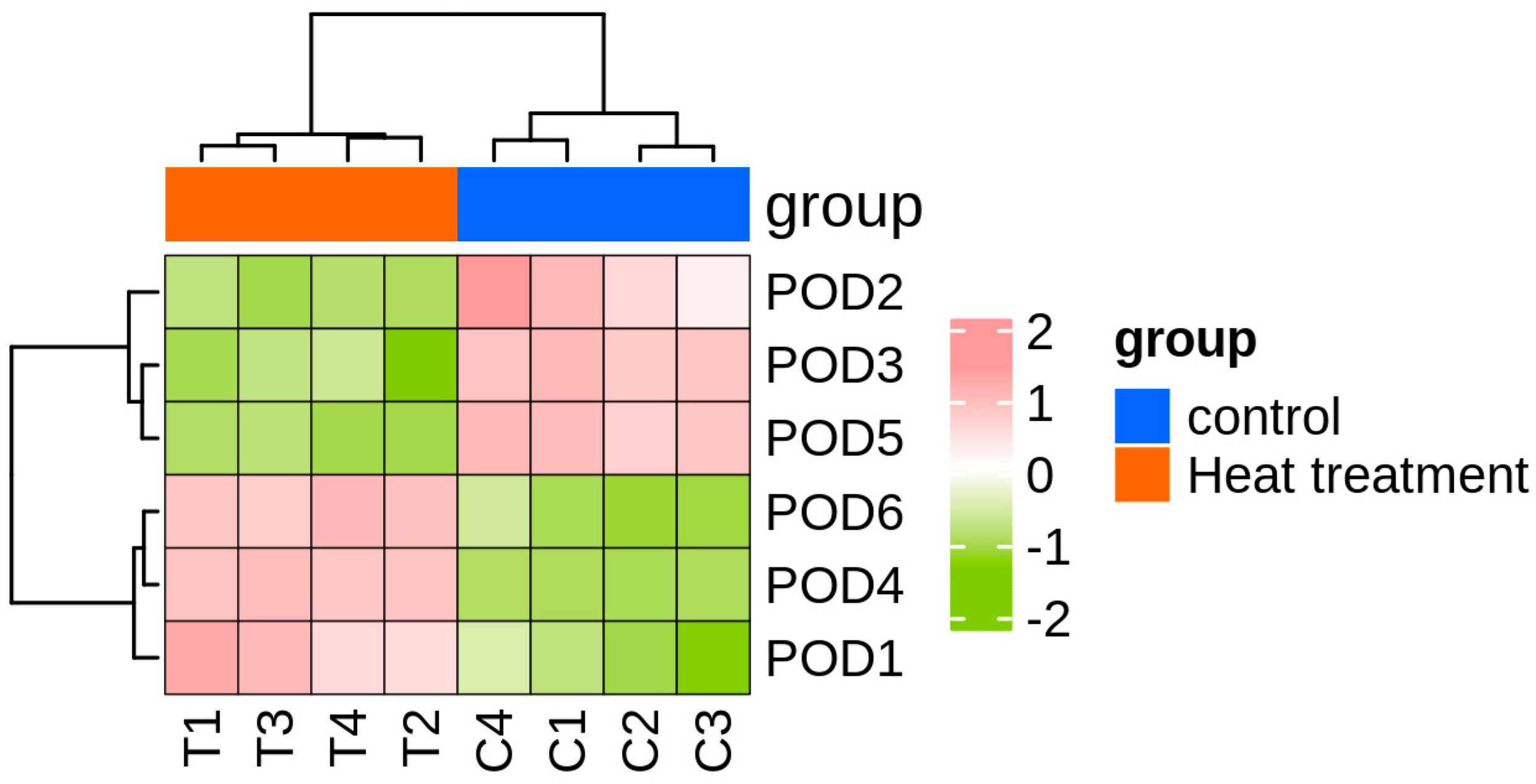


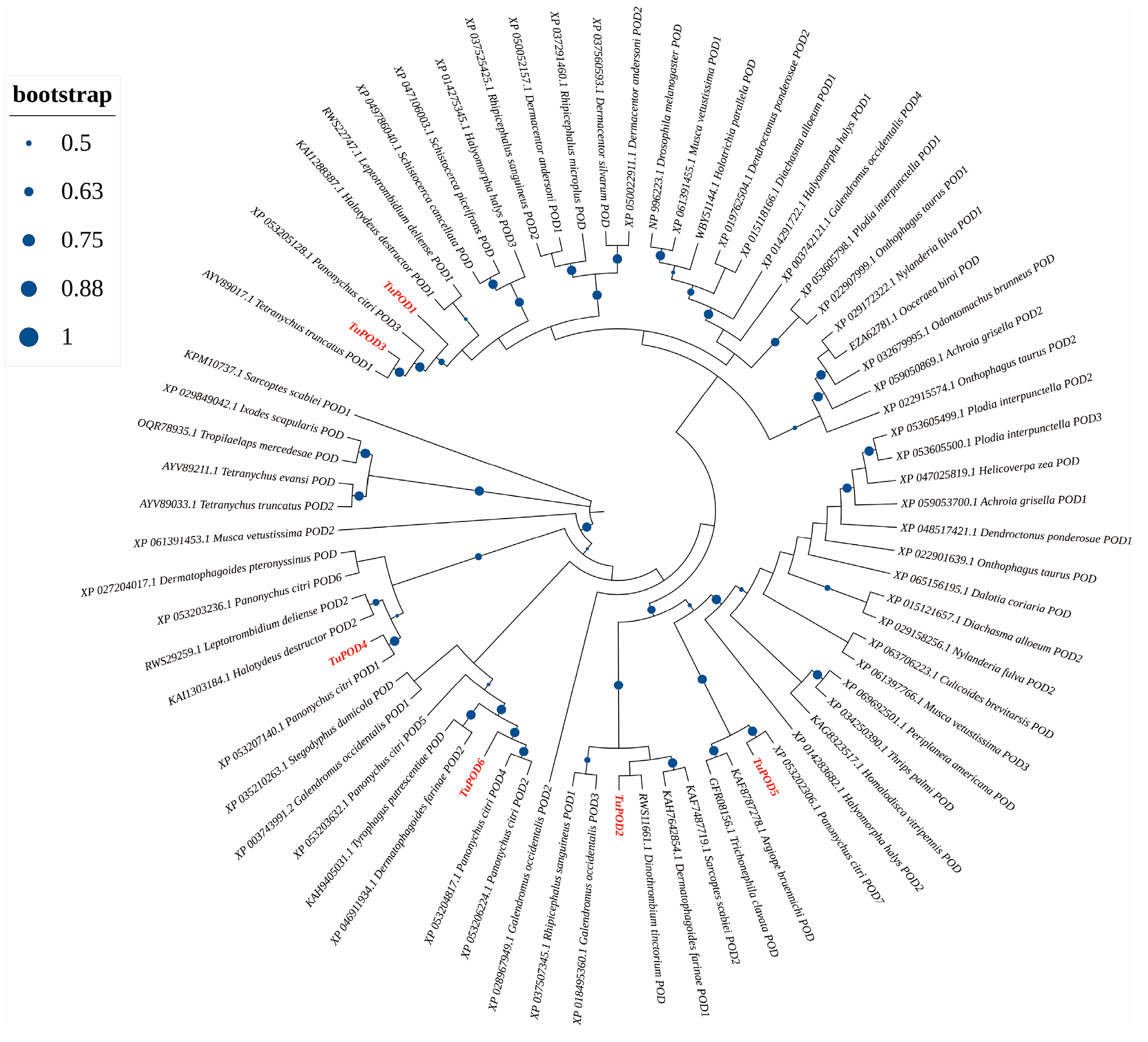
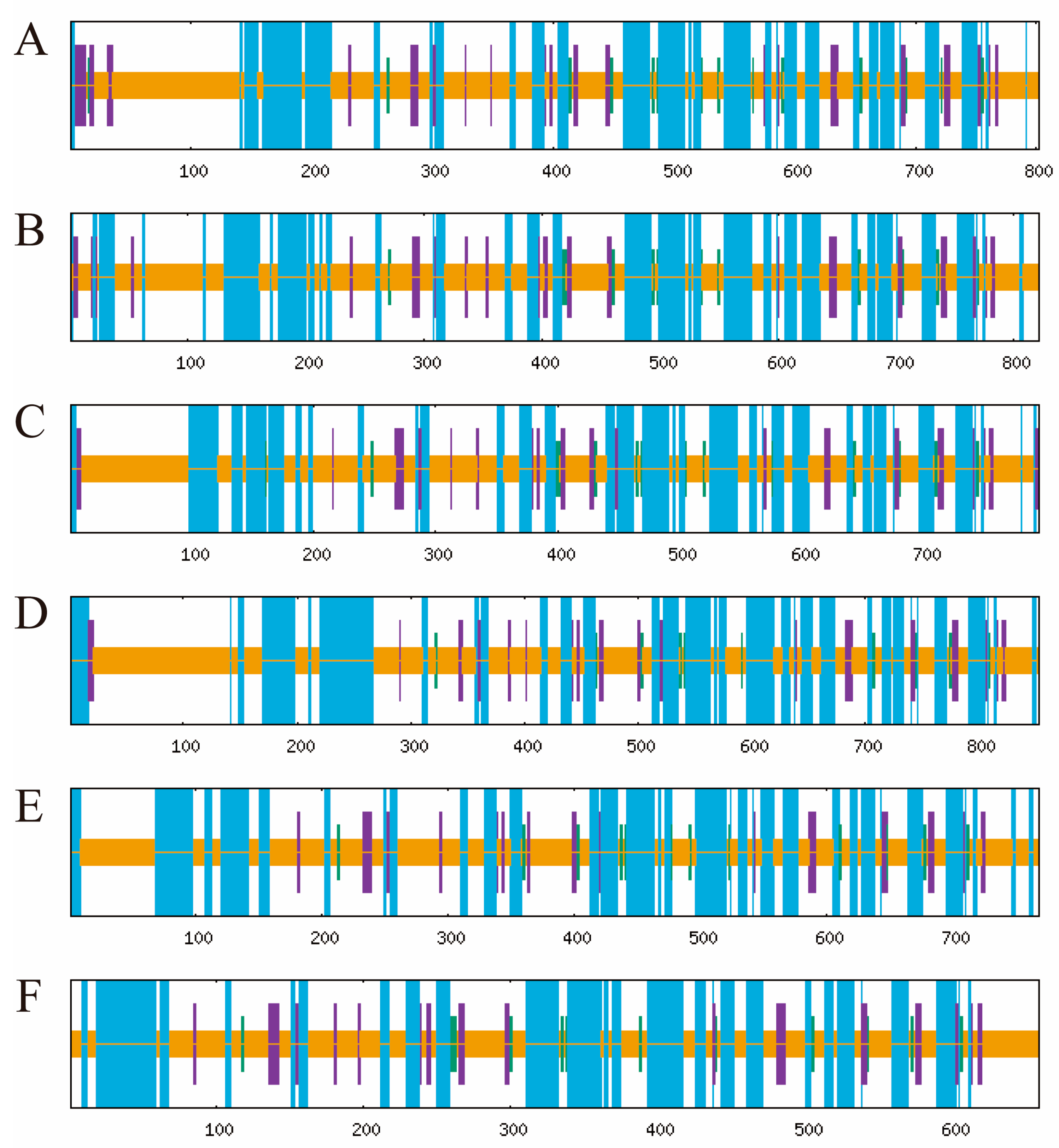
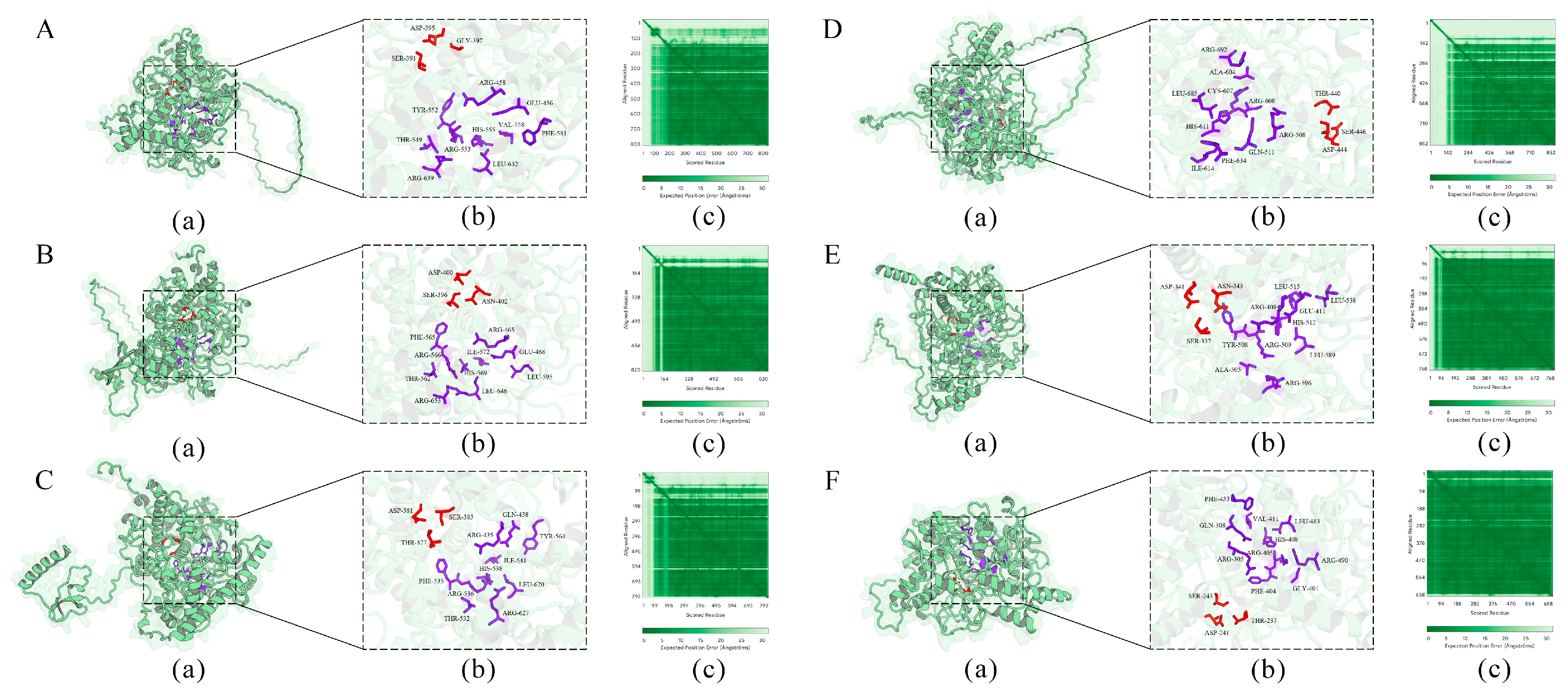
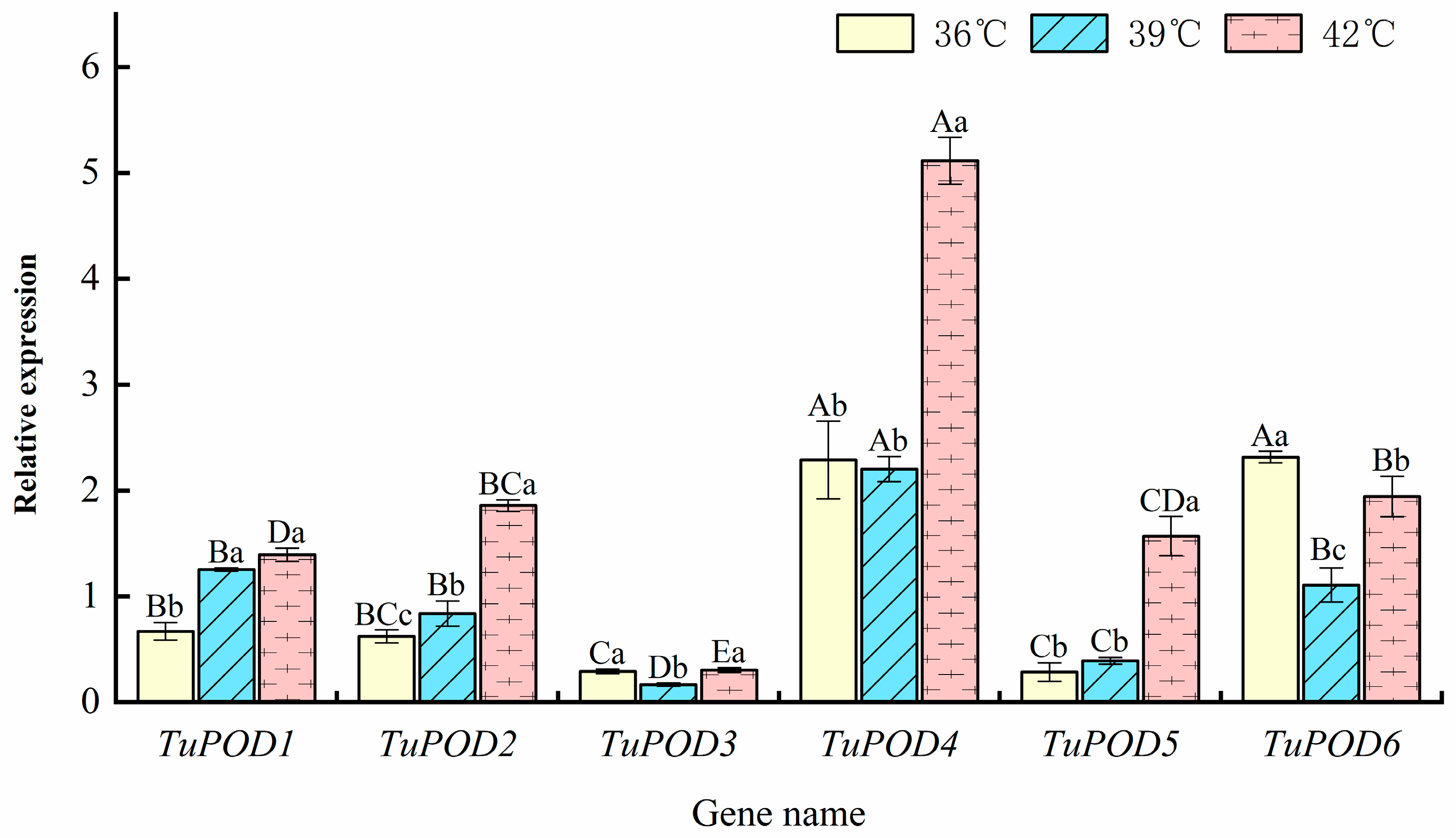
| Protein | Accession Numbers | Query Cover | E-Value | Identity |
|---|---|---|---|---|
| TuPOD1 | XP_025017963.1 peroxidase [Tetranychus urticae] | 100% | 0.0 | 100.00% |
| TuPOD2 | XP_015784100.1 peroxidase [Tetranychus urticae] | 100% | 0.0 | 100.00% |
| TuPOD3 | XP_015781195.1 peroxidase [Tetranychus urticae] | 100% | 0.0 | 100.00% |
| TuPOD4 | XP_015787917.1 peroxidase [Tetranychus urticae] | 100% | 0.0 | 100.00% |
| TuPOD5 | XP_015785823.1 peroxidase [Tetranychus urticae] | 100% | 0.0 | 100.00% |
| TuPOD6 | XP_015795696.1 peroxidase isoform X1 [Tetranychus urticae] | 100% | 0.0 | 100.00% |
| XP_025015959.1 peroxidase isoform X2 [Tetranychus urticae] | 100% | 0.0 | 100.00% | |
| XP_015795697.1 peroxidase isoform X3 [Tetranychus urticae] | 100% | 0.0 | 100.00% |
| Protein | aa | ORF | MW (KDa) | Isoelectric Point (pI) | Aliphatic Index | Instability Index | Hydrophilicity | N-Glycosylation Sites | Phosphorylation Sites | Signal Peptide | Transmembrane Helix | Subcellular Localization |
|---|---|---|---|---|---|---|---|---|---|---|---|---|
| TuPOD1 | 802 | 2409 | 89.09 | 8.16 | 91.33 | 54.34 | Hydrophilic | 2 | 78 | Yes | Yes | Plasma Membrane |
| TuPOD2 | 821 | 2466 | 92.67 | 6.07 | 84.36 | 49.55 | Hydrophilic | 2 | 77 | Yes | No | Plasma Membrane |
| TuPOD3 | 794 | 2385 | 88.12 | 5.02 | 87.81 | 40.05 | Hydrophilic | 10 | 90 | Yes | No | Plasma Membrane |
| TuPOD4 | 853 | 2562 | 95.91 | 8.29 | 78.02 | 49.69 | Hydrophilic | 4 | 90 | Yes | No | Plasma Membrane |
| TuPOD5 | 769 | 2310 | 87.03 | 6.17 | 82.22 | 44.88 | Hydrophilic | 1 | 67 | Yes | No | Plasma Membrane |
| TuPOD6 | 659 | 1980 | 74.81 | 6.88 | 67.22 | 40.13 | Hydrophilic | 2 | 58 | Yes | No | Cytoplasm |
| Protein Name | Alpha Helix | Extended Strand | Beta Turn | Random Coil |
|---|---|---|---|---|
| TuPOD1 | 274 (34.16%) | 69 (8.60%) | 26 (3.24%) | 433 (53.99%) |
| TuPOD2 | 298 (36.30%) | 60 (7.31%) | 20 (2.44%) | 443 (53.96%) |
| TuPOD3 | 282 (35.52%) | 58 (7.30%) | 22 (2.77%) | 432 (54.41%) |
| TuPOD4 | 313 (36.69%) | 51 (5.98%) | 18 (2.11%) | 471 (55.22%) |
| TuPOD5 | 289 (37.58%) | 48 (6.24%) | 20 (2.60%) | 412 (53.58%) |
| TuPOD6 | 257 (39.00%) | 50 (7.59%) | 22 (3.34%) | 330 (50.08%) |
Disclaimer/Publisher’s Note: The statements, opinions and data contained in all publications are solely those of the individual author(s) and contributor(s) and not of MDPI and/or the editor(s). MDPI and/or the editor(s) disclaim responsibility for any injury to people or property resulting from any ideas, methods, instructions or products referred to in the content. |
© 2025 by the authors. Licensee MDPI, Basel, Switzerland. This article is an open access article distributed under the terms and conditions of the Creative Commons Attribution (CC BY) license (https://creativecommons.org/licenses/by/4.0/).
Share and Cite
Chen, Y.; Liu, Y.; Wang, R.; Nie, P.; Wei, B.; Abdel-Fattah, R.S.; Shang, S.; Dewer, Y. Decoding Peroxidase Gene Function in Heat Stress Adaptation of Tetranychus urticae: Unraveling Molecular Mechanisms of Short-Term Thermal Tolerance. Antioxidants 2025, 14, 562. https://doi.org/10.3390/antiox14050562
Chen Y, Liu Y, Wang R, Nie P, Wei B, Abdel-Fattah RS, Shang S, Dewer Y. Decoding Peroxidase Gene Function in Heat Stress Adaptation of Tetranychus urticae: Unraveling Molecular Mechanisms of Short-Term Thermal Tolerance. Antioxidants. 2025; 14(5):562. https://doi.org/10.3390/antiox14050562
Chicago/Turabian StyleChen, Yaonian, Yuan Liu, Rangjun Wang, Pengcheng Nie, Bin Wei, Rasha S. Abdel-Fattah, Suqin Shang, and Youssef Dewer. 2025. "Decoding Peroxidase Gene Function in Heat Stress Adaptation of Tetranychus urticae: Unraveling Molecular Mechanisms of Short-Term Thermal Tolerance" Antioxidants 14, no. 5: 562. https://doi.org/10.3390/antiox14050562
APA StyleChen, Y., Liu, Y., Wang, R., Nie, P., Wei, B., Abdel-Fattah, R. S., Shang, S., & Dewer, Y. (2025). Decoding Peroxidase Gene Function in Heat Stress Adaptation of Tetranychus urticae: Unraveling Molecular Mechanisms of Short-Term Thermal Tolerance. Antioxidants, 14(5), 562. https://doi.org/10.3390/antiox14050562







